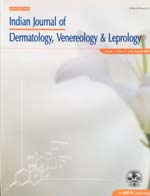
|
Indian Journal of Dermatology, Venereology and Leprology
Medknow Publications on behalf of The Indian Association of Dermatologists, Venereologists and Leprologists (IADVL)
ISSN: 0378-6323
EISSN: 0378-6323
Vol. 76, No. 3, 2010, pp. 254-258
|
 Bioline Code: dv10078
Bioline Code: dv10078
Full paper language: English
Document type: Research Article
Document available free of charge
|
|
|
Indian Journal of Dermatology, Venereology and Leprology, Vol. 76, No. 3, 2010, pp. 254-258
| en |
Topical placental extract: Does it increase the efficacy of narrowband UVB therapy in vitiligo?
Majid, Imran
Abstract
Background: Narrowband UVB therapy is presently one of the most effective therapies for generalized vitiligo. Many topical agents have been used in combination with narrowband UVB therapy to increase its efficacy in causing repigmentation in vitiligo. Placental extract is used topically usually in combination with sun exposure to cause repigmentation of vitiligo lesions.
Aims: The present study aims to study whether the efficacy of narrowband UVB therapy would be enhanced by addition of topical placental extract to the treatment regimen.
Methods: Ninety patients with vitiligo having more or less bilaterally symmetrical lesions on the face, trunk or limbs and receiving narrowband UVB therapy were enrolled for the study and instructed to apply topical placental extract (placentrex) lotion on their vitiligo lesions on the right side of the body. The other side of the body received narrowband UVB therapy alone and served as the control side. The extent of repigmentation achieved was assessed by VASI scoring and compared between the symmetrical lesions present on the two sides at monthly intervals and at the end of study period.
Results: Seventy-eight patients with 218 symmetrically distributed lesions, excluding those present on the hands or feet, were evaluated for study results at the end of treatment period. The time to onset of repigmentation as well as the mean NB-UVB dosage required was the same on the two sides. The mean repigmentation achieved was 63% (VASI score of 3.69) on the right (placental extract) sided lesions in comparison with 62% (VASI score of 3.60) on the left (control) sided lesions. Greater than 90% repigmentation was achieved in 70 symmetrical lesions in 24 patients. Of these 70 lesions, 39 were located on the right side of the body while 31 belonged to the left side of the body.
Conclusions: Addition of the topical placental extract was seen to have a modest but a statistically insignificant effect on the efficacy of NB-UVB therapy in causing repigmentation in vitiligo.
Keywords
Narrowband UVB therapy, topical placental extract, vitiligo
|
| |
© Copyright 2010 Indian Journal of Dermatology, Venereology, and Leprology.
Alternative site location: http://www.ijdvl.com
|
|
